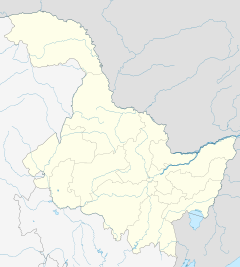Shuangyashan (simplified Chinese: 双鸭山; traditional Chinese: 雙鴨山; pinyin: Shuāngyāshān) is a coal mining prefecture-level city located in the eastern part Heilongjiang province, People's Republic of China, bordering Russia's Khabarovsk and Primorsky Krais to the east. The city's name means a pair-of-ducks mountains and refers to two peaks northeast of the city.[2] In 2007 the city had a GDP of RMB 20.6 billion with a 14.2% growth rate.
Shuangyashan
双鸭山市 | |
|---|---|
 New Year's Parade in February 2002 | |
 Location of Shuangyashan City (yellow) in Heilongjiang (light grey) and China | |
| Coordinates (Shuangyashan municipal government): 46°40′34″N 131°08′30″E / 46.6762°N 131.1416°E | |
| Country | People's Republic of China |
| Province | Heilongjiang |
| County-level divisions | 8 |
| Municipal seat | Jianshan District |
| Government | |
| • Type | Prefecture-level city |
| • CPC Shuangyashan Secretary | Li Xiangang (李显刚) |
| • Mayor | Wu Fengcheng (武凤呈) |
| Area | |
| • Prefecture-level city | 26,483 km2 (10,225 sq mi) |
| Population (2010)[1] | |
| • Prefecture-level city | 1,462,626 |
| • Urban | 507,257 |
| GDP | |
| • Prefecture-level city | CN¥ 43.3 billion US$ 7.0 billion |
| • Per capita | CN¥ 29,235 US$ 4,694 |
| Time zone | UTC+8 (China Standard) |
| Postal code | 155000 |
| Area code | 0469 |
| ISO 3166 code | CN-HL-05 |
| Licence plates | 黑J |
| Climate | Dwb |
| Shuangyashan | |||||||
|---|---|---|---|---|---|---|---|
 "Shuangyashan", as written in Chinese | |||||||
| Chinese name | |||||||
| Simplified Chinese | 双鸭山 | ||||||
| Traditional Chinese | 雙鴨山 | ||||||
| Literal meaning | double duck mountain | ||||||
| |||||||
| Manchu name | |||||||
| Manchu script | ᡧᡠᠸᠠᠩ ᠶᠠ ᡧᠠᠨ ᡥᠣᡨᠣᠨ | ||||||
| Romanization | Juru'niyehe'alin hoton | ||||||
| Russian name | |||||||
| Russian | Шуанъяшань | ||||||
Administrative divisions
edit| # | Name | Hanzi | Hanyu Pinyin | Population (2003 est.) | Area (km2) | Density (/km2) |
|---|---|---|---|---|---|---|
| 1 | Jianshan District | 尖山区 | Jiānshān Qū | 210,000 | 118 | 1,780 |
| 3 | Lingdong District | 岭东区 | Lǐngdōng Qū | 90,000 | 908 | 99 |
| 2 | Sifangtai District | 四方台区 | Sìfāngtái Qū | 70,000 | 169 | 414 |
| 4 | Baoshan District | 宝山区 | Bǎoshān Qū | 130,000 | 572 | 227 |
| 5 | Jixian County | 集贤县 | Jíxián Xiàn | 310,000 | 2,860 | 108 |
| 6 | Youyi County | 友谊县 | Yǒuyì Xiàn | 120,000 | 1,800 | 67 |
| 7 | Baoqing County | 宝清县 | Bǎoqīng Xiàn | 420,000 | 13,443 | 31 |
| 8 | Raohe County | 饶河县 | Ráohé Xiàn | 140,000 | 6,613 | 21 |
History
editShuangyashan was given its name in AD 1384 during the Ming Dynasty. However, few people lived in the area before coal was discovered there in 1914. In 1928 a major coal mining operation was established on the site and in 1946 the area was first designated a county. Shuangyashan was established as a special mining district in 1954 and officially designated a city by the CPC Central Committee and State Council in 1956.
Geography and climate
editResources
editShuangyashan is rich in coal, magnetite and marble. The proven coal reserves in the city total 11 billion tons, ranking first out of 13 prefecture and prefecture-level cities in the province. The magnetite reserves in Shuangyashan exceed 120 million tons, ranking first in Heilongjiang Province.
Climate
editThe city has a cold temperate monsoon climate, with long, cold, windy winters. The annual mean temperature in the city is 4.46 °C (40.0 °F).
| Climate data for Shuangyashan (1991–2020 normals, extremes 1981–2010) | |||||||||||||
|---|---|---|---|---|---|---|---|---|---|---|---|---|---|
| Month | Jan | Feb | Mar | Apr | May | Jun | Jul | Aug | Sep | Oct | Nov | Dec | Year |
| Record high °C (°F) | 2.9 (37.2) |
10.4 (50.7) |
20.4 (68.7) |
29.9 (85.8) |
33.8 (92.8) |
37.2 (99.0) |
38.2 (100.8) |
37.3 (99.1) |
32.2 (90.0) |
27.6 (81.7) |
16.8 (62.2) |
5.7 (42.3) |
38.2 (100.8) |
| Mean daily maximum °C (°F) | −11.4 (11.5) |
−6.4 (20.5) |
1.8 (35.2) |
12.4 (54.3) |
20.4 (68.7) |
25.2 (77.4) |
27.7 (81.9) |
26.1 (79.0) |
21.0 (69.8) |
11.9 (53.4) |
−0.7 (30.7) |
−10.1 (13.8) |
9.8 (49.7) |
| Daily mean °C (°F) | −16.1 (3.0) |
−11.4 (11.5) |
−3.1 (26.4) |
7.0 (44.6) |
14.6 (58.3) |
19.7 (67.5) |
22.9 (73.2) |
21.2 (70.2) |
15.3 (59.5) |
6.7 (44.1) |
−4.9 (23.2) |
−14.3 (6.3) |
4.8 (40.7) |
| Mean daily minimum °C (°F) | −19.5 (−3.1) |
−15.7 (3.7) |
−7.7 (18.1) |
1.8 (35.2) |
9.0 (48.2) |
14.6 (58.3) |
18.4 (65.1) |
17.0 (62.6) |
10.5 (50.9) |
2.2 (36.0) |
−8.5 (16.7) |
−17.5 (0.5) |
0.4 (32.7) |
| Record low °C (°F) | −32.8 (−27.0) |
−30.9 (−23.6) |
−23.2 (−9.8) |
−10.3 (13.5) |
−1.9 (28.6) |
3.5 (38.3) |
9.6 (49.3) |
7.8 (46.0) |
−1.8 (28.8) |
−13.1 (8.4) |
−26.4 (−15.5) |
−30.2 (−22.4) |
−32.8 (−27.0) |
| Average precipitation mm (inches) | 8.0 (0.31) |
5.5 (0.22) |
17.3 (0.68) |
29.3 (1.15) |
57.8 (2.28) |
81.4 (3.20) |
126.3 (4.97) |
117.1 (4.61) |
61.3 (2.41) |
34.1 (1.34) |
18.5 (0.73) |
11.9 (0.47) |
568.5 (22.37) |
| Average precipitation days (≥ 0.1 mm) | 6.9 | 5.0 | 7.9 | 8.9 | 12.3 | 14.0 | 13.5 | 14.3 | 10.4 | 7.7 | 7.0 | 8.1 | 116 |
| Average snowy days | 11.3 | 8.5 | 11.6 | 5.4 | 0.3 | 0 | 0 | 0 | 0 | 3.5 | 10.0 | 13.0 | 63.6 |
| Average relative humidity (%) | 65 | 58 | 52 | 49 | 56 | 68 | 74 | 77 | 68 | 56 | 58 | 65 | 62 |
| Mean monthly sunshine hours | 178.0 | 199.0 | 248.3 | 250.8 | 255.7 | 246.2 | 244.1 | 227.7 | 231.2 | 190.7 | 164.2 | 154.9 | 2,590.8 |
| Percent possible sunshine | 64 | 68 | 67 | 61 | 55 | 52 | 52 | 52 | 62 | 57 | 59 | 58 | 59 |
| Source: China Meteorological Administration[3][4] | |||||||||||||
Economy
editShuangyashan is a major center for coal mining. The city also produces steel, lumber, chemicals, building materials, textiles, electric machinery, and food products. In 2010, Shuangyashan's GDP reached RMB 37.67 billion, featuring a growth of 25% from a year ago.[5] The production output of steel and coal ranked the first and the second in Heilongjiang province. The region has attracted investments from large domestic companies such as Shandong Luneng Group and Jianlong Group. Tourism, retailing and wholesaling are also the pillars of the city's service sector.[6]
More recently, the city has been feeling the effects of the coal downturn, with mining demand collapsing amidst a slowdown in China's economic growth.[7]
Transportation
editA new high-speed railway station in Shuangyashan City is the Jiamusi Mudanjiang high-speed railway line, which can reach Harbin, Dalian, Shijiazhuang and other cities. The average time to Harbin is 3 hours and the average time to Jiamusi is 25 minutes. Shuangyashan is at the end of the Harbin to Shuangyashan railway spur link. 15 hours from Harbin by train, and 90 minutes from the closest prefecture-level city, Jiamusi. A freeway connects the town to Jiamusi over a distance of 57 km (35 mi). There is a modern coach service as well which does this trip in approximately 45 minutes. The city is 80 km (50 mi) from Jiamusi Airport, which operates regular flights to Beijing, Dalian, Shanghai, Qingdao, Guangzhou, Sanya and Khabarovsk.
Sight-seeing
editShuangyashan is surrounded by small mountains, and a large park based around one of these mountains forms a major feature of the outdoor life of the town. During the winter, this pine and elm-covered mountain forms an area for recreational activities.
References
edit- ^ 2010年黑龙江省第六次全国人口普查主要数据公报. Heilongjiang Bureau of Statistics (黑龙江省统计局). Archived from the original on 15 August 2013. Retrieved 11 May 2011.
- ^ 双鸭山城市介绍. jiaodong.net. 2008-09-15.
- ^ 中国气象数据网 – WeatherBk Data (in Simplified Chinese). China Meteorological Administration. Retrieved 5 July 2023.
- ^ 中国气象数据网 (in Simplified Chinese). China Meteorological Administration. Retrieved 5 July 2023.
- ^ 2010年双鸭山市国民经济和社会发展统计公报. Heilongjiang Bureau of Statistics.
- ^ Profiles of China Provinces, Cities and Industrial Parks
- ^ Zhou, Pinglang (2016-04-28). "Children of Coal: Life After the Collapse". Sixth Tone. Archived from the original on 2021-12-01. Retrieved 2023-01-10.
